The Moto E (2015) Review
by Brandon Chester on April 21, 2015 8:00 AM EST- Posted in
- Smartphones
- Motorola
- Mobile
- Moto E (2015)
Display
In the past few years we've seen a tremendous improvement in the quality of smartphone displays at every single price point. The display was often the first thing to be compromised when building a smartphone to meet a low cost, and the most inexpensive phones could ship with TN panels at resolutions as low as 480x320. But today even inexpensive smartphones like the Moto E have IPS displays and high enough resolutions to render text without overwhelming aliasing.
The 2015 Moto E has a 4.5" 960x540 IPS display, which makes it slightly less sharp than the original Moto E which had the same resolution on a 4.3" panel. However, a display's pixel density is just one of many attributes. To evaluate the various other aspects of the Moto E's display quality we turn to our standard smartphone display tests. As always, measurements are performed with X-Rite's i1Pro 2 spectrophotometer and SpectraCal's CalMAN 5 software, with the exception of contrast measurements which are done with an i1Display Pro colorimeter.
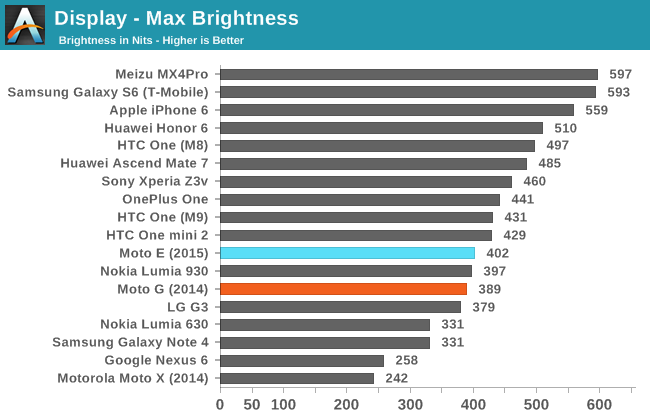
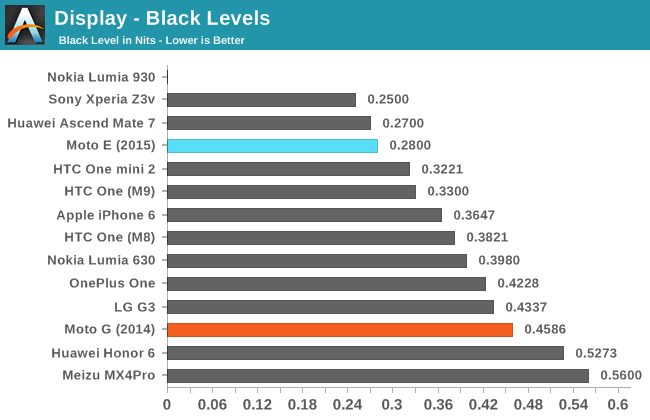
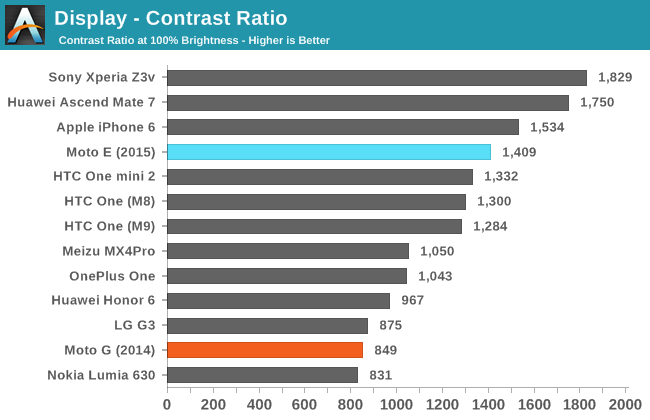
At 402 nits, the Moto E's display actually has a fairly good peak brightness. Black levels are also very good, which leads to a surprisingly high contrast ratio. It should be noted that the Moto E makes use of Content Adaptive Backlight Control (CABC), and dynamic contrast. The actual contrast ratio is closer to 1050:1, which is still a very good result.
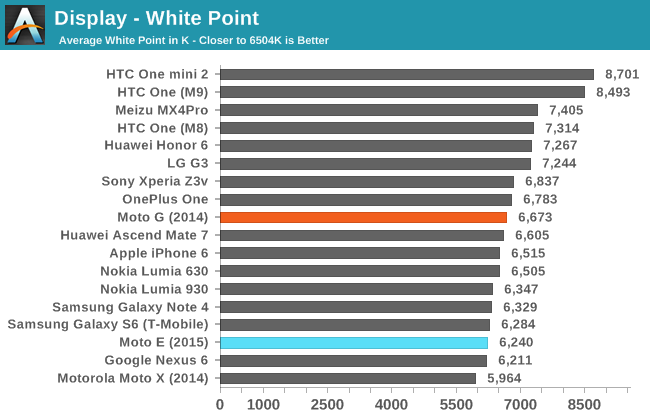
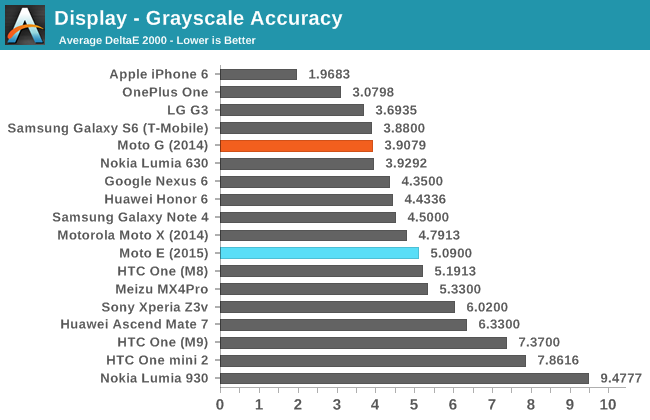
Greyscale results from the Moto E are unfortunately nothing exceptional. However, with a price point of $149 they are also not unexpected. The Moto E actually does not fare much worse than Motorola's flagship Moto X. The display's average white point tends toward the red as the blue component of luminance drops off when shades of grey approach white. The warm appearance of whites is definitely noticeable during use, but it's not highly bothersome.
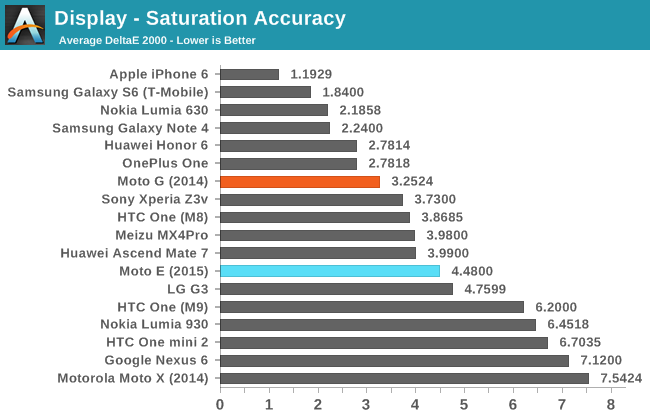
With saturations the Moto E actually performs better than I had expected it to. It's certainly imperfect, especially with blue and any secondary color with blue as a component, but with a price of $149 it surpassed my expectations of how well it would perform. The gamut itself is also larger than what one might expect from a budget IPS display.
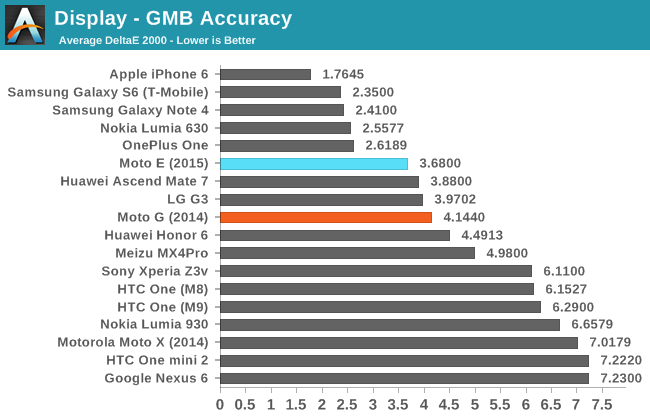
In the colorchecker test the Moto E does very well. While it isn't at the level of the most expensive flagships with calibrated displays, it beats out many devices that cost significantly more. The display is surprisingly accurate when displaying color mixtures, with much of the error coming from the issues with reproducing shades of grey.
Overall, the Moto E's display is actually much better than I had expected it to be. While I would really love if it were a 1280x720 panel, it's just not manageable with the price point that Motorola had to meet. Even so, text was still rendered fairly well, and colors were reproduced with much greater accuracy than I expected. If you have reasonable expectations of the Moto E's display when you purchase it, I think you'll find yourself pleasantly surprised.



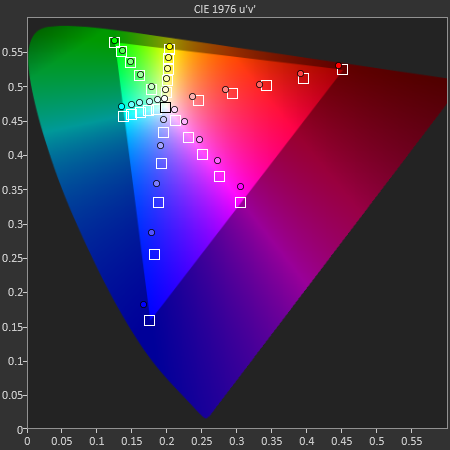
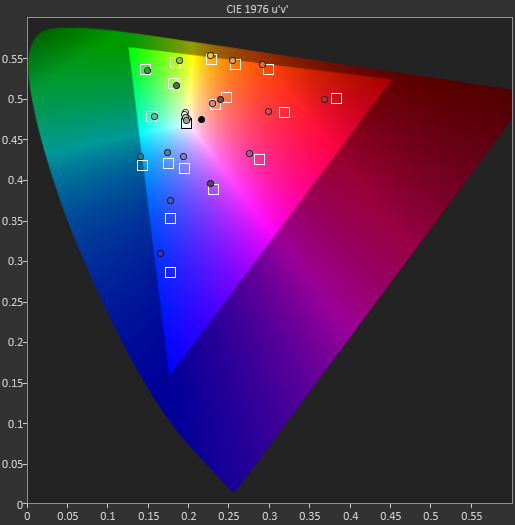








90 Comments
View All Comments
zepi - Tuesday, April 21, 2015 - link
How much does a 1A or 2A rated charger drop the charging times?I think it is a bit silly to compare chargers instead of phones.
arnoudw - Tuesday, April 21, 2015 - link
Exactly. I reviewed the phone as well (the European version) and the one that's for sale on this side of the ocean hasn't got a charger at all in the box. I just used another charger that I have to charge the phone and charge times were pretty normal: around 2,5 hours from zero to full.AT would maybe consider a disclaimer that chargers can differ per country or region and that can infuence the outcome of this particular test immensely. AT has got a worldwide audience and a lot of the potential buyers of this phone reading the review here might be from another part of the world. That's something for AT to consider, I guess.
TLDR; tested it as well, there was no charger included, charges normally with another charger.
sovking - Tuesday, April 21, 2015 - link
I agree. Charge time comparison should be done with the same charger or better with 2 or 3 chargers.Chargers for smarphone are universal, all devices connect to micro-usb chargers with 5V. At home we have more chargers for more smartphone and we do not matter which charger we are using.
So create a table showing a charging time when using 0.5A, 1A charger, 2A charger.
Some smartphone like Moto G 2014, limit input current, so it worth using until 1.5 A charger, more current is not used.
Ryan Smith - Tuesday, April 21, 2015 - link
To be clear here, the purpose is to test the charge time of the phone in its default configuration. It's not to compare just the chargers, but the entire package.hans_ober - Tuesday, April 21, 2015 - link
You've got a point; anyone who is buying this as their first Android (upgrading from an old Nokia), will most probably use the included charger and it was right to include the charge time using the 'package' the user would most probably use. However, since this is a case where the charger is to blame for the slow charging speeds, it would have been useful to include another result with another high powered charger, which would confirm that the phone IS capable of higher charging speeds if another charger is used and how much time could probably be saved by using a high powered charger.hans_ober - Wednesday, April 29, 2015 - link
Do you have a Quick charge 2.0 charger? The Motorola Turbo Charger? Just curious to see whether it works, because iirc QC 2.0 support was mentioned somewhere.victorson - Tuesday, April 21, 2015 - link
There is a mistake, the Moto E is not $109, it's actually $120 for the slow Snapdragon 200 version, and a not-so-cheap $150 for the Snadpragon 400 version. It's funny how the author can't think of competition when you have devices from Xiaomi and Meizu (among tens if not hundred others) that deliver better value for the money.close - Tuesday, April 21, 2015 - link
In EU the Moto E LTE is ~130E while the cheapest Xiaomi starts at ~170E. I wouldn't think twice.Brandon Chester - Tuesday, April 21, 2015 - link
The number of markets that you can purchase Xiaomi phones in is extremely small, you can count them on one hand. Also I apologize about the pricing error. There have been a few sales on it recently and for whatever reason I noted the price as $109. That being said, it does drop below Motorola's price very often. For example, it's currently available in India on Flipkart for $127 USD. India does happen to be an Xiaomi market and so I would definitely urge buyers there to check out their devices as well. But that's not an option for most buyers.victorson - Tuesday, April 21, 2015 - link
Thanks for the reply, Brandon! I agree that you can get the phone cheaper on sales and I wouldn't argue against the Moto E being an overall good value for the money, but it's also true that you can buy said Xiaomi phones (or many others for that matter, I don't want this to sound like an ad) from retailers like Pandawill.com, Coolicool.com, or others that ship internationally for free. And the user who said that Xiaomi starts at 170 euro, may want to pay a visit and see that prices on those sites start at around $120, not 170 euro.